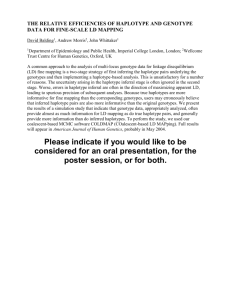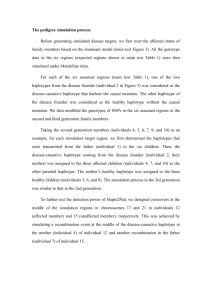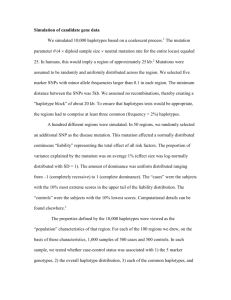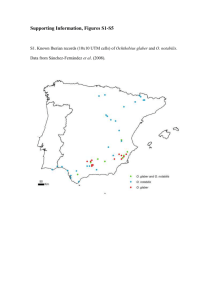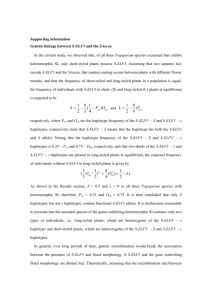Circumpolar analysis of morphological and genetic diversity in the Lepidurus arcticus
advertisement
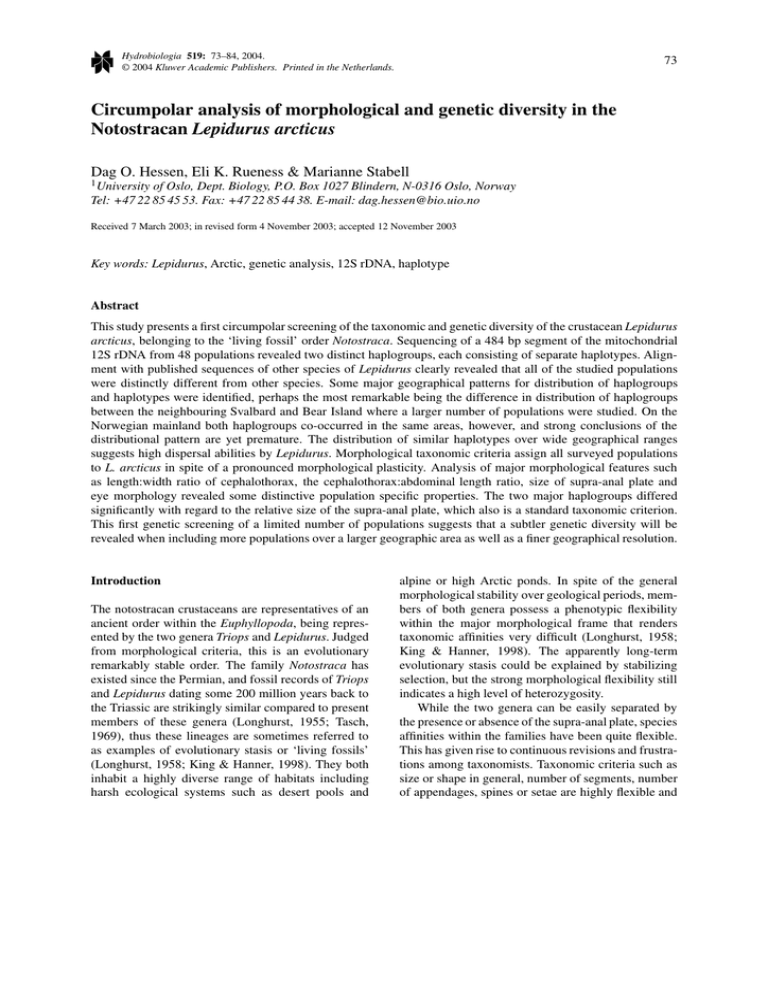
Hydrobiologia 519: 73–84, 2004. © 2004 Kluwer Academic Publishers. Printed in the Netherlands. 73 Circumpolar analysis of morphological and genetic diversity in the Notostracan Lepidurus arcticus Dag O. Hessen, Eli K. Rueness & Marianne Stabell 1 University of Oslo, Dept. Biology, P.O. Box 1027 Blindern, N-0316 Oslo, Norway Tel: +47 22 85 45 53. Fax: +47 22 85 44 38. E-mail: dag.hessen@bio.uio.no Received 7 March 2003; in revised form 4 November 2003; accepted 12 November 2003 Key words: Lepidurus, Arctic, genetic analysis, 12S rDNA, haplotype Abstract This study presents a first circumpolar screening of the taxonomic and genetic diversity of the crustacean Lepidurus arcticus, belonging to the ‘living fossil’ order Notostraca. Sequencing of a 484 bp segment of the mitochondrial 12S rDNA from 48 populations revealed two distinct haplogroups, each consisting of separate haplotypes. Alignment with published sequences of other species of Lepidurus clearly revealed that all of the studied populations were distinctly different from other species. Some major geographical patterns for distribution of haplogroups and haplotypes were identified, perhaps the most remarkable being the difference in distribution of haplogroups between the neighbouring Svalbard and Bear Island where a larger number of populations were studied. On the Norwegian mainland both haplogroups co-occurred in the same areas, however, and strong conclusions of the distributional pattern are yet premature. The distribution of similar haplotypes over wide geographical ranges suggests high dispersal abilities by Lepidurus. Morphological taxonomic criteria assign all surveyed populations to L. arcticus in spite of a pronounced morphological plasticity. Analysis of major morphological features such as length:width ratio of cephalothorax, the cephalothorax:abdominal length ratio, size of supra-anal plate and eye morphology revealed some distinctive population specific properties. The two major haplogroups differed significantly with regard to the relative size of the supra-anal plate, which also is a standard taxonomic criterion. This first genetic screening of a limited number of populations suggests that a subtler genetic diversity will be revealed when including more populations over a larger geographic area as well as a finer geographical resolution. Introduction The notostracan crustaceans are representatives of an ancient order within the Euphyllopoda, being represented by the two genera Triops and Lepidurus. Judged from morphological criteria, this is an evolutionary remarkably stable order. The family Notostraca has existed since the Permian, and fossil records of Triops and Lepidurus dating some 200 million years back to the Triassic are strikingly similar compared to present members of these genera (Longhurst, 1955; Tasch, 1969), thus these lineages are sometimes referred to as examples of evolutionary stasis or ‘living fossils’ (Longhurst, 1958; King & Hanner, 1998). They both inhabit a highly diverse range of habitats including harsh ecological systems such as desert pools and alpine or high Arctic ponds. In spite of the general morphological stability over geological periods, members of both genera possess a phenotypic flexibility within the major morphological frame that renders taxonomic affinities very difficult (Longhurst, 1958; King & Hanner, 1998). The apparently long-term evolutionary stasis could be explained by stabilizing selection, but the strong morphological flexibility still indicates a high level of heterozygosity. While the two genera can be easily separated by the presence or absence of the supra-anal plate, species affinities within the families have been quite flexible. This has given rise to continuous revisions and frustrations among taxonomists. Taxonomic criteria such as size or shape in general, number of segments, number of appendages, spines or setae are highly flexible and 74 Figure 1. Map displaying the geographical distribution of haplotypes. Sample localities are denoted as in Table 1, c = Canada, g = Greenland, r = Russia, s = Svalbard, b = Bear Island and n = Norway. Haplogroup A haplotypes are showed as squares (A1 = black, A2 = grey and A3 = white) and haplogroup B as circles (B1 = black and B2 = white). in general of limited taxonomic value. Moreover, these criteria may also to some extent undergo allometric or ontogenetic changes. Studies of North American species of Lepidurus based on allozyme studies and sequencing of a 330 bp 12S rDNA subunit confirmed the presence of five distinct species, yet with a rather pronounced macrogeographical overlap (King & Hanner, 1998). This study did, however not include L. arcticus. The taxonomic affinities of the Lepidurus groups are not finally settled, but Longhurst (1955) claims in his extensive survey of the Notostraca that L. arcticus is easily recognized from morphological criteria and its pattern of distribution. Yet it may possess a striking morphological flexibility even over a restricted geographical scale (Linder, 1952; Longhurst, 1958; Borgstrøm & Larsson, 1974). The species L. arcticus has a circumpolar distribution, and may occur both in shallow moraine ponds and large lakes in subarctic areas. During the Pleistocene glaciations, the species was apparently far more widespread in western Europe than presently (Bennie, 1894; Longhurst, 1955). Sømme (1934) describes the species as a boreo- alpine relict in Scandinavia occurring at the sea-level in the Arctic, but at progressively greater altitudes towards the south. On the Norwegian mainland, it is a typically alpine species that inhabits a wide range of localities, frequently co-occurring with fish (Brown trout, Salmo trutta and/or Arctic charr, Salvelinus alpinus) in deep and large lakes. In shallow localities it does only rarely co-occur with fish, however (cf., Jeppesen et al., 2001), and a long tradition with fish stocking of alpine lakes may have reduced its occurrence over large areas. As an omnivore and a predator of smaller crustaceans like Daphnia (Christoffersen, 2001), it may also act as a major player for the structure of the communities in many localities. Because of its variable size and shape and its wide range of geographical and ecological distribution, L. arcticus is an interesting candidate to investigate intraspecific genetic diversity in a circumpolar analysis. In parallel, approximately half of the samples, representing all major, geographical regions, were scored for taxonomic criteria. At its southern range of distribution, this species is at threat due to climatic changes and immigration of predators such as min- 75 Figure 2. Map of Bear Island with the surveyed localities given as numbers corresponding to those of Table 1. All populations except no. 26 were assigned to haplogroup B. now (Phoxinus phoxium L.). A taxonomic and genetic verification of the uniqueness of these southern populations is thus important from a conservationist point of view. Further, a taxonomic examination may also reveal historic patterns of colonization, founder effects and local adaptations. Genetic studies of other arctic freshwater invertebrates like the planktonic crustacean Daphnia (Colbourne et al., 1998; Weider et al., 1999a,b) and the bryozoan Cristella mucedo (Freeland et al., 2000, 2003) have revealed geographical differences in haplotype diversity. This partly reflects past glaciation and immigration history. Also high arctic populations commonly reproduce asexually and have high dispersal abilities via resting eggs (ephippia) or statoblasts. The reproductive mode of Lepidurus arcticus is not finally verified, and is assumed to differ with latitude, with hermaphrodites and self-fertilization as a common strategy at high latitudes (Longhurst, 1955). As a first attempt to assess the genetic diversity of Lepidurus arcticus over a vast geographical area, scattered populations across the polar regions were analysed. To study genetic differences on a smaller scale, a large number of localities were sampled on the isolated and remote Bear Island. Material and methods A total of 127 individuals of Lepidurus arcticus , representing 48 populations, were sampled for genetic and morphological analyses (Table 1 and Fig. 1). This included 34 localities on Bear Island (Fig. 2), 7 localities on Svalbard, 7 localities on the Norwegian mainland (including both northern and southern alpine localities), 3 localities in Russia, one on Greenland (Thule) and one in Canada (Banks Island, North West 76 Table 1. Sample localities, n = number of individuals analysed. Individuals from localities marked with x were also used for morphological measurements. Region Coordinate Locality # Bear Island 79◦ 30 N 19◦ E Svalbard 78◦ 3 N 13◦ 47 E b13 b14 b15 b21 b22 x b23 b25 b26 b27 b28 b29 x b33 x b42 b51 b52 x b54 x b56 x b57 b58 b59 x b60 x b62 x b64 x b65 b66 x b67 x b68 b70 b72 s1 x s3 x s4 x s5 s8 s9 s12 n101 n102 n103 n110 n111 n112 x n200 x g210 x c220 x r230 x r231 x r232 x 48 78◦ 55 N 11◦ 58 E Norway Greenland Canada Russia Total 68◦ 16 N 17◦ 26 E 66◦ 10 N 12◦ 55 E 66◦ 11 N 12◦ 57 E 60◦ 15 N 7◦ 20 E 60◦ 15 N 7◦ 20 E 60◦ 55 N 7◦ 12 E 60◦ 11 N 7◦ 17 E 77◦ 40 N 69◦ 0 E 73◦ 15 N 121◦ 30 E 72◦ 23 N 139◦ 53 E 70◦ 11 N 67◦ 17 E 68◦ 53 N 53◦ 34 E Sampling year 99 99 99 99 98 98 98 98 98 98 98 98 98 99 99 99 99 99 99 99 99 99 98 98 99 99 99 99 99 99 01 01 01 97 97 97 99 99 99 97 98 00 99 99 99 94 94 94 n 5 5 5 5 3 3 3 3 2 4 5 5 5 5 2 3 3 3 2 1 1 1 1 1 1 1 1 1 1 6 2 2 4 2 1 1 5 4 1 2 2 2 4 2 2 2 1 1 127 Haplotype B1 B1 B1 B1/B2 (1/4) B2 B1 B1 A1 B1/B2 B2 B1 B1 B2 B1 B1/B2 B1 B1 B1 B2 B1 B1 B2 B2 B1 B1 B1 B1 B1 B1 A1 A1 A1 A1 A1 A1 A1 A3 B2 B2 B2 B2 B2 A1/B2 (2/2) A2 A2 A1 B2 B2 77 Territories). A subsample of 22 populations representing all geographical areas studied in this survey were screened for major taxonomic criteria. Samples were taken by surface net hauls, except from one of the alpine localities on mainland Norway (no. 200), where samples were obtained from gut contents of brown trout. The animals were immediately transferred to absolute EtOH and stored at 4 ◦ C prior to analysis. 1 to 8 individuals from each locality were analysed both for genetic and morphological characteristics (cf. Table 1). Genetic analysis Total DNA was extracted using a modified procedure originally described by Doyle & Doyle (1987). The tail of each adult specimen or an intact juvenile individual was digested in 1 ml 2 × CTAB solution with 10µl Proteinase K (10 mg ml−1 ) and incubated at 60 ◦ C for approximately 1 h before DNA was extracted with phenol/chloroform, precipitated with EtOH and dissolved in 50 µl dH2 O. DNA was amplified using mitochondrial 12S rDNA primers designed by comparing 12S sequences from Daphnia pulex (Van Raay & Crease, 1994) and Artemia fransiscana (Perez et al., 1994). The sequence of the primers are:12S upper: 5 -TACTACTAAATCCACCTT-3 , and 12S lower: 5 -AAGTTTGAATCTRGCT-3. PCR amplifications were performed in 50 µl volumes containing 2.5 mM MgCl2 , 1× PCR buffer, 0.2 mM dNTP, 4pmol of each primer and 0.5 U Taq DNA polymerase (Abgene, Surrey, UK) using 30 cycles with the following conditions: denaturing 30 s at 95 ◦ C, annealing 30 s at 50 ◦ C, extension 60 s at 72 ◦ C on a Biometra Tgradient Thermocycler. PCR products were directly sequenced using the 12S lower primer on an automated sequencer (ABI373A). We chose to sequence the 3 -end as it has been shown to be the most variable (Neefs et al., 1991). In addition a few individuals were sequenced for comparisons with other earlier published 12S sequences of various Lepidurus species. As these sequences are located further to the less variable 5 -end of the gene a different set of PCR primers originally developed for Daphnia pulex was used: 12SF: 5 -ATGCACTTTCCAGTACACCTAC-3 , and AAA: 5 -AAATCGTGCCAGCCGTCGC-3 (the same protocols for PCR and sequencing were followed). Sequences were aligned manually using the software SeqApp (Gibert, 1992). The sequences were submitted to GenBank and have been assigned accession numbers AJ583698-AJ583702 for the five haplotypes. We com- Figure 3. Morphological parameters included in the surveyed populations. CL = Carapace length, CW = Carapace width, TL = Telson length, TS = Telson setae, AS = number of anal segments, SP = length of supra-anal plate. Figure 4. Network dispaying the relationship between the five L. arcticus haplotypes. Haplotypes are shown as circles, each break on the lines connecting the haplotypes indicates one mutational differences. The small circle indicates an intermediate haplotype missing from our data. pared sequences of L. arcticus to 12S data from other Lepidurus species downloaded from GenBank (for accession numbers see the legend to Fig. 5). Genetic distances were calculated using PAUP* (Swofford, 2002), where distances are given as uncorrected p. A phylogenetic tree was constructed applying a maximum likelihood approach (exhaustive search) and tested for statistical confidence using 1000 bootstrap replicates in PAUP∗ (Swofford, 2002). Triops was used as an outgroup (accession number given in the legend to Fig. 5). Morphological analysis Females from a subset of the sampled localities were also scored for major morphological features. While there is a strong morphological flexibility among populations, there could also be an allometric effect of 78 Table 2. Variable nucleotide positions in a 484 bases segment of the 12S rDNA of L. arcticus. Numbers above refer to nucleotide position, gaps are shown as hyphens and sequence identity to the top reference sequence (haplotype A1) is denoted by dots. H = Haplotype, n = number of individuals. H n 37 123 135 141 148 149 195 196 199 212 219 275 298 444 447 A1 A2 A3 B1 B2 25 4 5 56 37 T T . . C . G . A . . G . . A A T . . – – T – – – – T . . C C G . . A A C . T . . – – – A A C T T T T A . G . . A . . T T T C . . . T . . C C . A A morphological parameters that renders a strict comparison between animals of different sizes difficult. Nevertheless, we believe that the selected parameters should eventually reveal systematic deviations between populations. For a total of 77 individuals from 22 localities, the following parameters were measured from EtOH-fixed specimens under a Leitz 1800 stereomicroscope at 100× magnification to the nearest 0.1 mm (see Fig. 3): Length and width of carapace (cephalothorax) (CL and CW), length of telson (TL) from carapace to end of the supra-anal plate, length of intact telson setae (TS), length of supra-anal plate (SP) and total number of abdominal segments (AS). Special features were also noted on specimens from the various localities. From the locality on Banks Island (Canada), only two males were available for morphological analysis. Due to a sexual dimorphism, especially concerning the supra-anal plate, the morphological parameters from this population should be considered with caution. Table 3. Pairwise genetic distances between L. arcticus 12S haplotypes (3 end) calculated by PAUP∗ . Haplotypes A1 A2 A3 B1 B2 Pairwise genetic distances A1 A2 A3 B1 0.0042 0.0083 0.0167 0.0146 0.0021 0.0083 0.0167 0.0146 0.0208 0.0187 Results Sequence divergence A total of 489 bp of the mitochondrial 12S gene were sequenced and compared among 127 individuals. The five haplotypes that were found divided into two haplogroups, A and B (Table 2), a network showing the relationship between the haplotypes is given in Figure 4. The two most abundant haplotypes within each group, A1 and B1, differed by 8 point mutations and a two bp length mutation. Group A was most diverse and included three haplotypes A1-A3, with A2 and A3 being separated from A1 by four and two point mutations, respectively, in addition to a 1 bp length difference. The two haplotypes B1 and B2 differed in one nucleotide position. All of the observed point mutations were transitions. This corresponds to genetic distances ranging from 0.0021 (between B1 and B2) to 0.0208 (between A3 and B1), see Table 3. Geographical distribution of haplotypes The large-scale geographic distribution of haplotypes is given in Figure 1. On the isolated Bear Island, where the majority of the samples were taken (cf. Table 1), all localities but one (b26) contained B haplotypes. B1 and B2 did co-occur in three of the 29 localities. Haplotype B1 was unique to Bear Island while B2 was also found in six of the seven localities on the Norwegian mainland and in the two westernmost localities in Russia (r231 and r232). On Svalbard all seven localities contained exclusively haplotype A1 individuals. A1 was also found in one single locality on Bear Island (b26) as well as in two individuals sampled in eastern Russia (r230). The haplotype A3 was only found on a single locality in the northern part of the Norwegian mainland (n101), where all sampled individuals (5) displayed this haplotype. A2 was found in the popula- 79 Comparison with other species The phylogenetic relationship between our haplotypes A1 and B1 and previously published sequences from other Lepidurus species collected in North America (King & Hanner, 1998) and Germany (Braband et al., 2002) is visualized as a maximum likelihood tree (Fig. 5). L. arcticus is clearly distinct from the other species in the genus, and the genetic distance separating A1 and B1 (0.006) was considerably lower than any distances observed between the other species (ranging from 0.049 to 0.126; Table 4). The closest relative to L arcticus in the maximum likelihood tree (Fig. 5) was found to be L. couesii sampled in Manitoba, Canada by King & Hanner (1998), interestingly, their northernmost sample. Morphological characteristics Figure 5. Maximum likelihood phylogram based on 330 bp of the 5 end of 12S region showing the relationship between L. arcticus haplotype A1 and B1 and some other species within the genus Lepidurus. Bootstrap values calculated using a maximum likelihood (above diagonal) and maximum parsimony (below diagonal) are given next to the branches. The other species and their corresponding accession numbers are: L. couesii∗ (AJ000827), L. lemmoni (AJ000830), L. bilobatus (AJ000831), L. couesii (AJ000829), L. packardi (AJ000822), L. apus (AF494483) and as an outgroup Triops longicaudatus (AJ000817) was used. King & Hanner (1998), showed that the species L. couesii, was polyphyletic, what is here denoted L. couesii∗ was sampled from Manitoba, Canada. tion analysed from Greenland (g210) as well as in the population from Canadian Banks Island (c220). The only locality where A and B haplotypes co-occurred was a quite large lake (n200) at the Hardangervidda mountain plain in southern Norway. This sample was, contrary to the others, taken from the gut contents of a fish that possibly could have exploited other lakes within the same watercourse. Based on common, morphological criteria (cf. Longhurst, 1955; Enckell, 1980), all populations were assigned to Lepidurus arcticus. The number of body segments was 27 in most populations, although a few individuals displayed 26 segments. The size of the supra-anal plate was small in all populations, and distinctively smaller that of the closely related species L. apus. The males form Banks Island were an exception, however this could probably be ascribed to the sexual dimorphism. The range of the key characteristics is provided in Figure 6. While carapax length versus carapace width, length of telson setae and supra-anal plate all provided a strong correlation across populations, there was a wide scatter in carapax length versus telson length. There were no significant differences between the two major haplotypes A1 and B1 with regard to morphological characteristics, except for the supraanal plate being significantly smaller in haplotype A1 populations relative to body size (p < 0.001, one-way ANOVA, Table 5). The relative size of the supra-anal plates surely represents the most relevant taxonomic criterion of those tested here. Some of the populations displayed other distinctive features that were not shared by other populations of the same haplotype. One of the B2 haplotype pond populations from the alpine Hardangervidda area (southern Norway) had a remarkably small telson length relative to the carapace. This population was also characterized by a ‘protruded’ eye form (cf. Longhurst, 1955) that was not reported from the other populations. One of the A1 haplotype populations from Svalbard also possessed a distinctive feature with 80 Figure 6. Scatterplot of major taxonomic criteria for the four major haplotypes darkened rings on the distal part of the telson setae. Apart from being exceptionally large, the individuals from eastern Siberia also had remarkable strong carinal spines. Discussion Several 12S haplotypes, divided into two distinct haplogroups (A and B), were identified among L. arcticus from a circumpolar range of localities. Both A and B haplotypes were found over vast geographic areas, but also in proximity and in one case even in the same locality. The existence of two distinct haplogroups 81 must be explained either by historical isolation (for instance in different glacial refugia) or some sort of reproductive isolation (niche differentiation). From the present distribution, and as the dispersal abilities and reproductive strategies of these organisms are poorly understood, none of the explanations can be excluded. On a circumpolar scale our sampling was, with the exception of on Bear Island, quite scattered and it is reasonable to believe that a denser sampling would reveal a greater diversity of haplotypes both in the Nearctic and Palearctic areas. Perhaps the most striking pattern was the presence of different haplogroups between the neighbouring Bear Island and Svalbard. The single locality at Bear Island housing haplotype A1 was situated in close vicinity to ponds with the most common haplotype B1 (cf. Fig. 2). The B2 haplotype that co-occurred with the B1 haplotype was also randomly distributed over the island. All the surveyed populations at Svalbard belonged to the A1 haplotype. Three of the Svalbard localities were situated within the same area at Kapp Linné (close to 78◦ N, in the vicinity of Longyearbyen), while the other four were situated further north, close to Ny-Ålesund at 79◦ N. One of these four localities was remotely situated from the others and also far from the shore in the inner part of Kongsfjorden. Since L. arcticus occurs in coastal areas over the entire Archipelago (Olofsson, 1918; Sømme, 1934; Halvorsen & Gullestad, 1978), it is resonable to believe that a higher haplotype diversity than revealed by our study exists on Svalbard. Although the occurrence of different haplotypes at Bear Island and Svalbard indicates low north-south dispersal abilities between these Arctic islands, the widespread occurrence of some haplotypes (like A1) nevertheless suggests dispersal via migrationg birds over long distances. Summerhayes & Elton (1923) observed how terns on Bear Island commonly preyed on Lepidurus, and also a number of other migrating birds species prey on these in shallow tundra ponds (Mæhlum, 1989). While it is unlikely that adults are dispersed over long distances, resting eggs may do so, either by viability after gut passage or embedded in mud attached to feets or feathers. Other invertebrates like the cladoceran Daphnia species complex (Van Ray & Crease, 1995; Coulbourne et al., 1999; Weider et al., 1999a,b) and the bryozoan Cristella mucedo (Freeland et al., 2000, 2003) as well as plants (Abbott & Brochmann, 2003) show haplotype dispersal over vast areas at both sides of the Atlantic which most likely must be accredited to dispersal by migrating birds (Weider & Hobæk, 2003). L. arcticus inhabits numerous localities in arctic and sub-arctic circumpolar areas from approximately 60◦ N to 80◦ N (Sømme, 1934; Longhurst, 1955; Vekhoff, 1997; Sayenko & Minakawa, 1999), and is recorded from all major arctic regions. Our data are too scattered to confirm a higher genetic diversity in ice-free refugia like Beringia with a subsequent radiation after deglaciation which has been demonstrated for a number of arctic plants and invertebrates (cf., Abbott & Brochman, 2003; Freeland et al., 2000, 2003; Weider & Hobæk, 2003). Fossil remains dating back to 13 000 years B.P have been recorded in coastal lakes of northern Norway that has been ice-free for at least 22 000 years (Solem & Alm, 1994), suggesting a possibility also for postglacial radiation from local refugia. The evolution and haplotype divergence in many arctic organisms have been accredited to glaciation events during the Pleistocene. For the Notostraca, the reported genetic divergence may very well be a result of past isolation events. The total dominance of a single haplotype within a given region, like Bear Island, may reflect migration barriers, although one could also invoke some kind of ‘monopolization hypothesis’ (DeMeester et al., 2002), where the original founder haplotype rapidly expands its population size and prevents later colonisations. Judged from allozyme analysis, however, several thousands of distinct clones have been identified in Arctic Daphnia (cf. Beaton & Hebert, 1988; Hobæk et al., 1993; Weider et al., 1999a). Even within small and shallow ponds where an almost complete spatial and nutritional niche overlap must be assumed, several clones may coexist. This clonal richness contradicts the commonly held belief that the high Arctic ecosystems have low genetic diversity (Weider & Hobæk, 2000). Reproductive strategies will have strong bearings on the establishment of genetic diversity. For many plants and invertebrates, there is a transition from facultative parthenogenesis in temperate regions towards obligate parthenogenesis in the Arctic. Repeated and rapid invasion by new clones could explain the astonishing number of different clones that is commonly recorded for Arctic Daphnia, yet the source of this genetic variation is more likely to originate from previous events of recombination, rather than within-clone mutations (Vrijenhoek, 1998). The mode of reproduction is far from being certain in the Notostracans. Males are rarely recorded 82 Table 4. Pairwise genetic distances between Lepidurus species based on 5 end of 12S sequences calculated by PAUP∗ . 1 L. arct. A 2 L. arct. B 3 couesii ∗ 4 lemmoni 5 bilobatus 6 couesii 7 packardi 8 apus 9 Triops Pairwise genetic distances 1 2 3 4 5 6 7 8 0.0061 0.0582 0.0703 0.0733 0.0918 0.0673 0.0488 0.1327 0.0491 0.0737 0.0707 0.0520 0.1303 0.0675 0.0646 0.0580 0.1393 0.0830 0.0825 0.1429 0.0643 0.1303 0.1265 0.0582 0.0642 0.0733 0.0917 0.0673 0.0427 0.1327 0.0920 0.0858 0.1261 0.0953 0.0797 0.1337 (Sømme, 1934), but most early authors have suggested that L. arcticus are hermaphroditic (Longhurst, 1955; Arnold, 1967; Butler et al., 1980). If high arctic Lepidurus can also actually reproduce parthenogenetically, a high clonal diversity might add to the haplotype diversity as has been demonstrated for Daphnia. While the general benefit of asexual reproduction still is under scrutiny, there is no doubt that asexuality promotes dispersal abilities since single individuals or eggs may be sufficient to found new populations. More samples are required before final conclusions on the relationship between haplotype and taxonomic criteria can be drawn. It is nevertheless noteworthy that there were clear differences in the relative size of the supra-anal plate (a key taxonomic criterion, cf., Longhurst, 1955; Enckell, 1980) between the haplogroups. The A1 haplotype in the Svalbard localities represented a group with extremely short supra-anal plates, while the same haplotype from Shirokostan (Siberia) had somewhat longer plates, and the Greenlandic A2 haplotype did not differ from the B haplogroups with regard to this criterion. Also the remarkably short telson relative to carapax that was found in one of the isolated ponds on the Hardangervidda plateu is noteworthy, since this feature was not shared among the other B2 haplotypes. This calls for a closer examination of associations between haplotypes and morphology, but clearly the supra-anal plate as a taxonomic criterion was supported by the division into major haplogroups. It should be stressed though, that there is no direct causal link between the observed differences in mitochondrial DNA and the morphological trait. The morphological plasticity in the notostracans is well recognized (Linder, 1952; Longhurst, 1955, 1958). Also juvenile stages within L. arcticus from different areas may show pronounced morphological variability. Borgstrøm & Larsson (1974) suggested, based on comparison between larval stages described from Greenland (Poulsen, 1940) with populations from southern Norway, that these geographical areas might house different subspecies of L. arcticus. Undoubtedly a closer examination of morphological features could have revealed a subtler pattern among populations and haplotypes, but it is noteworthy that these populations provide examples on morhological plasticity within a given haplotype. L. arcticus is clearly distinct from the other species in the genus. Our comparison with published sequences of the other northern species of Lepidurus revealed that one of the two distinctive L. couesii haplotypes (King & Hanner, 1998) was the closest relative to L. arcticus (cf. Fig. 5). Interestingly, this was a population of L. couesii sampled in Manitoba, Canada by King & Hanner (1998), which was their northernmost sample. L. couesii and L. arcticus can be morphologically separated, among other criteria, from morphological affinities of the supra-anal plate (Enckell, 1980) This major taxonomic criterion also supported the distinction between the two major haplogroups found within the species L. arcticus. Our data does not suggest any separation at the sub-species level within L. arcticus, however. This study confirms the general findings from genetic surveys of other arctic organisms, that low species diversity may hold a richer genetic diversity. From a biodiversity point of view, this has also implica- 83 Table 5. Bivariate fit by linear regressions for major morphological criteria (pooled data, upper table) and pairwise comparisons (one-way Anova, lower table) for length ratio between supra annal plate and total length as well as ratio between SAP and carapace length by major haplotypes A and B. Abbreviations: Length and width of carapace (cephalothorax) (LC and WC), length of telson (LT), length of intact telson setae (LTS), length of supra-anal plate (LSP). LT = 0.638 + 0.48 LC, r 2 = 0.25, p < 0.0001 LTS = 1.125 + 0.79 LC, r 2 = 0.43, p < 0.0001 LSP = 0.262 + 0.11 LC, r 2 = 0.18, p < 0.0001 WC = 1.638 + 0.81 LC, r 2 = 0.54, p < 0.0001 LSP:LC ratio by haplotype LSP:LC ratio by haplotype DF F -ratio p 1 1 16.74 44.43 < 0.0001 < 0.0001 tions for conservation management. L. arcticus may be considered as a relict species over its southern range of distribution, and it is at threat in several of these localities due to extensive stocking and immigration of fish, acidification and global warming. These considerations call for a further examination of the genetic affinities especially over its marginal range of distribution. Acknowledgements This study was supported by The Norwegian Research Council, project grant 121181/720 to D.O. Hessen. We are most indebted to Kirsten Christoffersen, Reidar Borgstrøm, Geir Dahl Hansen, Anders Hobæk and Anders Klemetsen for providing samples for the analysis, and to Christian Brochman and an anonymous reviewer for providing most valuable comments and suggestions. References Abbott, R. J. & C. Brochmann, 2003. History and evolution on the arctic flora: in the footsteps of Eric Hultén. Molecular Ecology 12: 299–313. Arnold, G. P., 1967. Observations on Lepidurus arcticus (Pallas) (Crustacea: Notostraca) in East Greenland. Ann. Mag. Nat. Hist. 13: 599–617. Beaton, M. J . & P. D. N. Hebert, 1988. Geographical parthenogenesis and polyploidy in Daphnia pulex. Am. Nat. 132: 837–845. Bennie, J., 1894. Arctic plants in the old lake deposits of Scotland. Ann. Scot. Nat. Hist 3: 46. Borgstrøm, R. & P. Larsson, 1974. The first three instars of Lepidurus arcticus (Pallas), (Crustacea: Notostraca). Norw. J. Zool. 22: 45–52. Braband, A., S. Richter, R. Hiesel & G. Scholtz, 2002. Phylogenetic relationships within the Phyllopoda (Crustacea, Branchiopoda) based on mitochondrial and nuclear markers. Mol. Phylogenet. Evol. 25: 229–244 Butler, M., M. C. Miller & S. Mozley, 1980. Macrobenthos. In Hobbie, J. E (ed.), Limnology of Tundra Ponds. Dowden, Hutchinson and Ross, Stroudsburg, Penn, Barrow, Alaska: 297–339. Christoffersen, K., 2001. Predation on Daphnia pulex by Lepidurus arcticus. Hydrobiologia 442: 223–229. Colbourne, J. K., T.J. Crease, L. J. Weider, P. D. N. Hebert, F. Dufresne & A. Hobæk, 1998. Phylogenetics and evolution of a circumarctic species complex (Cladocera: Daphnia pulex). Biol. J. Linn. Soc. 65: 347–365. De Meester, L., A. Gómez, B. Okamura & K. Schwenk, 2002. The monopolization hypothesis and the dispersal-gene flow paradox in aquatic organisms. Acta Oecologia 23: 121–135. Doyle, J. J. & J. L. Doyle, 1987. A rapid DNA isolation procedure for small amounts of fresh leaf tissue. Phytochem. Bull. 19: 11– 15. Enckell, P. H., 1980. Kräftdjur. Lund , Signum. Freeland, J. R., C. Romualdi & B. Okamura, 2000. Gene flow and genetic diversity: a comparison of freshwater bryozoan populations in Europe and North America. Heredity 85: 498–508. Freeland, J. R., V. K. Rimmer & B. Okamura, 2003. Evidence for a rresudual post-glacial founder effect in a highly dispersive freshwater invertebrate. Limnol. Oceanogr. (in press). Gilbert, D. G., 1992. SeqApp. A biosequence editor & analysis application. http://iubio.bio.indiana.edu: 7780/perl/custom/index. cgi?dir=/public/molbio/dna/display/SeqApp Halvorsen, G. & N. Gullestad. 1978. Freshwater Crustacea in some areas of Svalbard. Arch. Hydrobiol. 78: 383–395. Hobæk, A., L. J. Weider & H. G. Wolf, 1993. Ecological genetics of Norwegian Daphnia III. Clonal richness in an apomictic complex. Heredity 71: 323–330. Jeppesen, E., K. Christoffersen, F. Landkildehus, T. Lauridsen, S. Amsinck, F. Riget & M. Søndergaard, 2001. The fish and crustaceans in Northeast Greenland lakes with special emphasis on interactions between Arctic charr (Salvelinus alpinus), Lepidurus arcticus and benthic chydorids. Hydrobiologia 442: 329–337. King, J. L. & R. Hanner, 1998. Cryptic species in a ‘living fossil’; lineage: taxonomic and phylogenetic relationships within the genus Lepidurus (Crustacea: Notostraca) in North America. Mol. Phylogenet. Evol. 10: 23–36. Linder, F, 1952. Contribution to morphology and taxonomy of the Branchiopoda, notostraca, with special reference to North American species. Proc. U.S. Natn. Museum. 102: 1–69. Longhurst, A. R, 1955. A review of the Notostraca. Bull. Br. Mus. 3: 1–57. Longhurst, A. R, 1958. Abnormal variation in the Notostraca. Syst. Zool. 7: 84–88. Mæhlum, F, 1989. Birds and mammals on Svalbard. Norwegian Polar Insitute, ISBN 82-90307-57-8. Neefs, J. M., Y. Van de Peer, P. De Rijk, A. Goris & R. De Wachter, 1991. Compilation of small ribosomal subunit RNA sequences. Nucleic Acids Res. 19 Suppl.: 1987–2015. Olofsson, O., 1918. Studien über die Süsswasserfauna Spitzbergens. Zool. Bidr. Upps. 6: 183–646. Perez, M. L., J. R. Valverde, B. Batuecas, F. Amat, R. Marco, R. & R. Garesse, 1994. Speciation in the Artemia genus: mitochondrial DNA analysis of bisexual and parthenogenetic brine shrimps. J. Mol. Evol. 38: 156–168. 84 Poulsen, E. M., 1940. Biological remarks on Lepidurus arcticus Pallas, Daphnia pulex de Geer and Chydorus sphaericus O.F.M. Meddr. Grønland 131: 1–50. Sayenko, E. M. & N. Minakawa, 1999. Occurence of two species of crustaceans, Branchinecta paludosa (O. F. Müller, 1788) (Anostraca) and Lepidurus arcticus (Pallas, 1793) (Notostraca), on the Kuril archipelago. Crustaceana 72: 710–712. Solem, J. O. & T. Alm, 1994. Southward migration of freshwater invertebrates from Northern Norway. Fauna Norvegica Ser. A 15: 9–18. Summerhayes, V. S. & C. S. Elton, 1923. Contribution to the Ecology of Spitsbergen and Bear Island. The Journal of Ecology 11: 215–286. Swofford, D., 2002. PAUP* 4.0 (Sinauer Associates). Sømme, S., 1934. Contributions to the biology of Norwegian fish food animals I. Lepidurus arcticus Pallas. Avh. Norske Vidensk Akad 6: 1–36. Tasch, P., 1969. Branchiopoda. In Moore, R. C. (ed.), Treatise on Invertebrate Paleontology. Geological Survey of America, Lawrence: 128–191. Van Raay, T. J., & T. J. Crease, 1994. Partial mitochondrial DNA sequence of the crustacean Daphnia pulex. Curr. Genet. 25: 66– 72. Van Raay, T. J., & T. J. Crease, 1995. Mitochondrial DNA diversity in an apomictic Daphnia complex from the Canadian high arctic. Mol. Ecol. 4: 149–161. Vekhoff, N. V., 1997. Large branchiopod Crustacea (Anostraca, Notostraca, Spinicaudata) of the Barents region of Russia. Hydrobiologia 359: 69–74. Vrijenhoek, R. C., 1998. Animal clones and diversity. Bioscience 48: 388–395. Weider, L. J. & A. Hobæk, 2000. Phylogeography and arctic biodiversity: a review. Ann. Zool. Fenn. 37: 217–231. Weider, L. J. & A. Hobæk, 2003. Glacial refugia, haplotype distributions, and clonal richness of the Daphnia pulex complex in arctic Canada. Molecular Ecology 12: 463–473. Weider, L. J., A. Hobæk, J. K. Colbourne, T. J. Crease, F. Dufresne & P. D. N. Hebert, 1999a. Holarctic phylogeography of an asexual species complex. I. Mitochondrial DNA variation in arctic Daphnia. Evolution 53: 777–792. Weider, L. J., A. Hobæk, P. D. N.Hebert & T. J. Crease, 1999b. Holarctic phylogeography of an asexual species complex. II. Allozymic variation and clonal structure in arctic Daphnia. Molecular Ecology 8: 1–13.

